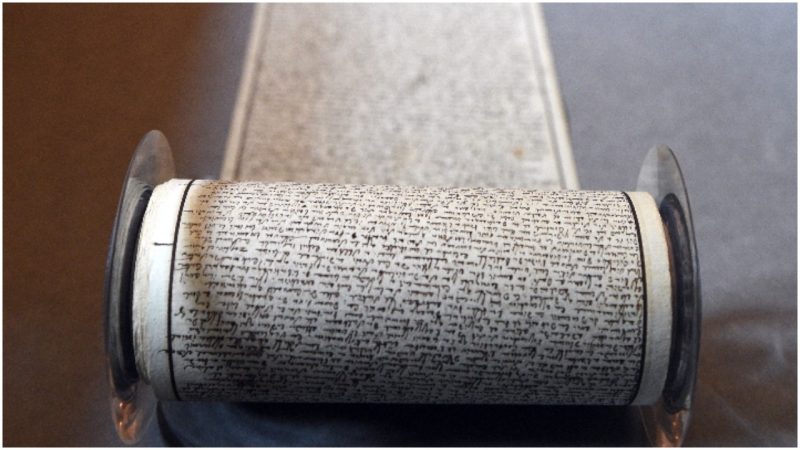The original manuscript of the Marquis de Sade’s 120 Days of Sodom was recently subjected to an interesting twist of fate―it was deemed a “national treasure” by the French government just hours before it was to be auctioned and had to be removed from the sale.
Since the Marquis de Sade has managed to remain controversial to this day, the decision to forbid the sale and keep the manuscript in its homeland of France baffled many of the spectators in the Aguttes auction house, in Paris.
De Sade’s magnum opus, dubbed by some the “Gospel of Evil” and called by the author himself “the most impure tale that has ever been told since our world began,” has divided opinions for more than a century since it was published in 1904, 111 years after it was written.
The reason for this ill reception is obvious to anyone who has ever come into contact with the book or is in any way introduced to the concept of sadism, named after the libertine Marquis.

The plot summary includes four wealthy libertines, who seclude themselves in a castle in the French countryside, together with their entourage of young women and men, who become victims of random sexual and physical abuse over a course of 120 days.
The book, filled with controversial segments, also acts as a catalog to more than 600 individual types of perversion, including orgies, torture, rape, and bestiality. What makes the book much more than a product of a depraved mind is the aspect in which the writer quite vividly dissects and explains the logic and connection between sexuality and abuse of power.
It has often been deemed as pure pornographic fiction, even though, over the years, many notable intellectuals have stood in its defense. 120 Days of Sodom was written in the confinement of the Bastille fortress―the infamous French pre-revolutionary prison in which de Sade was serving one of his many sentences due to indecent behavior and blasphemy.
In dire conditions, de Sade wrote the manuscript using a 39-foot-long roll of paper which he had previously glued together, creating a scroll. He hid the manuscript inside the wall of his cell, and once the Bastille was stormed on July 14, 1789, the only thing that the nobleman could think of was his scroll, and whether or not the paper roll fell victim to the angry mob that looted the castle, marking the beginning of the French Revolution.
Even though the manuscript somehow survived the turmoil of the revolutionary years, it was still considered by the Sade family as a disgrace which should never see the light of day. By pure chance, the manuscript was acquired by a Berlin-based psychiatrist, Iwan Bloch, who finally published the original version in 1904. It wasn’t until the mid-20th century that the book began to attract attention in France, the United Kingdom, and the United States.
Over the course of years, it has shifted owners and ended up as an exhibit of the Museum of Letters and Manuscripts in Paris. In 2015, it was seized by the French authorities after it was concluded that the owner of the museum, a Swiss citizen named Gérard Lhéritier, and his investment firm, Aristophil, were involved in a large-scale financial fraud. Since then, the manuscript has been in the hands of the French Ministry of Culture, together with 130,000 other documents of historic value, all of which were part of Lhéritier’s collection.

Apart from de Sade’s manuscript, the auction that was halted due to government intervention had intended to sell one other interesting piece of literary history―Andre Breton’s Surrealist Manifestos. The original manifesto of the surrealist movement was estimated to be worth around 4 million euros. Together with de Sade, Breton’s writing shall remain in France until indefinite, as the act of proclaiming their original texts as national treasures forbids them from being exported from France.
The Ministry of Culture has made claims to obtain legal rights to the two manuscripts by purchasing them at international market rates, which, by Lhéritier’s estimation, might reach 17.5 million euros. Whether the speculation is correct is yet to be confirmed.
The Swiss art collector and entrepreneur initially bought the de Sade manuscript, as a private owner, for a price of 6.1 million euros in 2014, and later sold it to Aristophil for 12.5 million.
Since 2015, the company has been locked in a scandal, when it was accused of embezzling up to 850 million euros of investors’ money. This incident enabled the Ministry to come into possession of original manuscripts by famous writers such as Alexandre Dumas and Honore de Balzac, and even powerful political figures of the likes of Napoleon and Admiral Nelson.
The Museum’s collection also includes a 40-page first-hand account written by Helen Churchill, who was among the lucky survivors of the Titanic. Her written testimony became largely known as it served as an inspiration for the 1997 Oscar-winning blockbuster, named after the ill-fated ship. This document and many others have already been put to auction.
What exactly made the French Ministry enact such “divine intervention” and prevent the two manuscripts from leaving their homeland remains unknown to the public.
Related story from us: Ancient manuscripts in Mount Sinai library reveal languages lost long ago
The strange journey of de Sade’s 39-foot-long manuscript continues to amaze and puzzle many, so much so that one begs to ask, is this the end to its 200-year-old wanderings?
